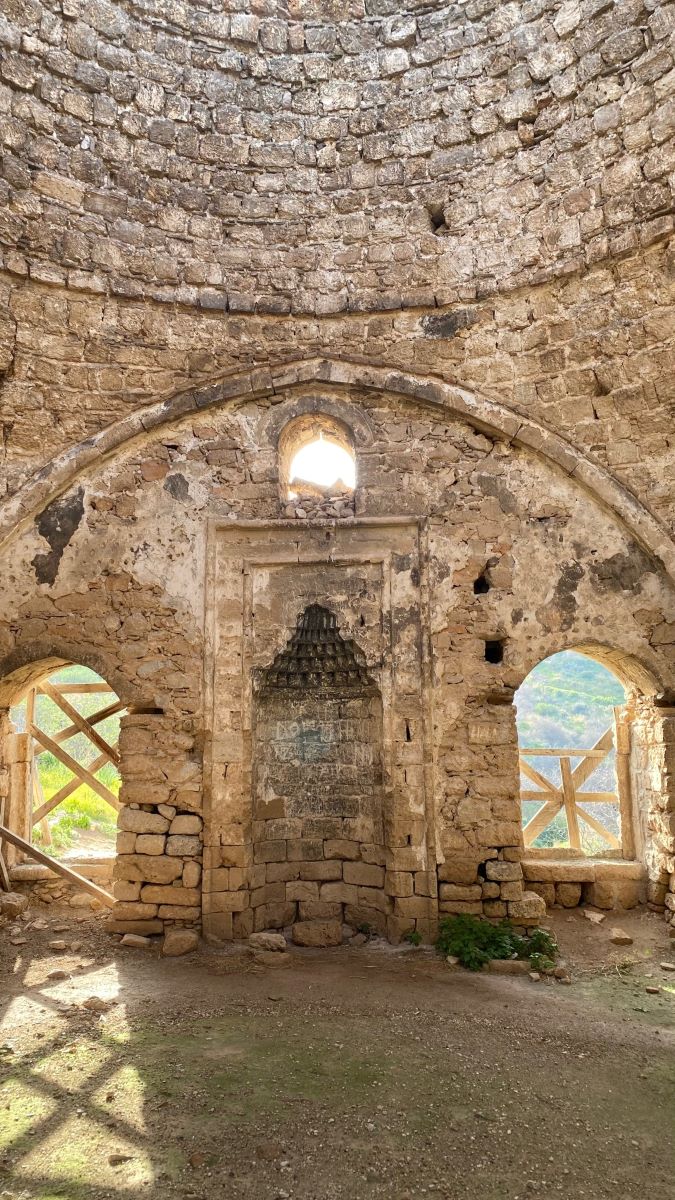Acrocorinth: Information to Visit for History & Views
Greek Island Bucket List is an Amazon Associate and participant in other affiliate programmes. I earn from qualifying purchases. Please see my disclaimer for more information.
I absolutely recommend that if you’re able-bodied, you find a way to head up to the top of the Acrocorinth monolith and castle.
It rises up behind the archaeological site of Ancient Corinth, and the two sets of ruins are often visited together by independent travellers. But I’ve noticed that many organised tours skip it, which I think is a shame.
Why the Site Gets Missed
It is a trek even just to get up from the car park to past the main entrance. To completely explore the site, you’ll do more uphill hiking. But your rewards are magnificent views and meadow-like walks.
To be fair, you don’t have to go to the highest point to get amazing views of the wider area. You can get good views even just from the car park.

View of the sea from the car park
History of the Site
Acrocorinth was the Peloponnese’s most significant fortress. The hill is naturally somewhat secure and close to the Isthmus, so strategically important.
It was occupied when ancient and medieval Corinth were important commercial centres and one of the most important Greek city states.
New fortifications were added over time, and the site was ruled by various people over the years. (If you want in-depth history, have a look at the Archaeological Museum of Ancient Corinth’s official website)
It was the last line of defence in southern Greece, but the Roman army demolished all the fortifications in 146 BC. That was at the same time they destroyed Corinth, and Julius Ceasar made Corinth a Roman colony. Later, in the middle Byzantine Period, the castle was rebuilt.
After that, it was again occupied and developed by several leaders, and Acrocorinth was modernised in 1458 AD by the Ottoman Turks.
In 1821, during the Greek War of Independence, Acrocorinth was besieged, and it was finally liberated in 1823.
The Castle of Acrocorinth
The castle took up the whole of the flat area at the top of the hill. Two – three thousand-meter-long walls fortified the area around it, and you can still see some of those today.
The main entrance is on the west side. That part of the hill isn’t as rocky, so to make the area less vulnerable, there was a moat and three fortification walls built. That’s the section you still enter through today.
In medieval times, a settlement developed between the second and third walls. Most of the houses were owned by Christians and Muslims, with main homes in Corinth city. But they sought refuge in the castle town when pirates invaded.
As well as houses, there were churches, mosques, fountains, baths, cisterns and military buildings in this area by the gates. The site also had a secure water supply.
Things to Look Out For
Like many of Greece’s ancient sites, not much of Acrocorinth’s fortress remains, and what is, isn’t well signed with information. But don’t mistake this for a really short visit. Depending on what you enjoy, you can spend plenty of time walking around this site.

In the spring and summer, it’s like a walk in the countryside with bees buzzing and butterflies darting around. Even in the autumn and winter, it can be a pleasant place to stroll around.

Just take care on blustery days (in any season), where access to the Frankish tower will be limited to the inside.
Frankish tower
This is the southwestern tower that’s about 530 metres above sea level. It’s rectangular with an underground cistern covered by a vault, part of which is preserved. The main section is also vaulted, and there’s a roof that you can access on good weather days.

You can get up to the tower following the path and then the natural steps in the rocks. Apparently, the last part would historically have been access by a moveable wooden ladder. But now, there’s a steep metal ladder, like you’d use to access a loft.


View of the remains of the fortified citadel walls seen from the Frankish tower roof
Sanctuary of Aphrodite
The remains of the temple dedicated to the goddess Aphrodite (the goddess of love in Greek mythology) are at the site’s highest peak. When I’ve visited, it’s always been a peaceful spot since many people don’t make the trek all the way up that path.

Remains of the Temple of Aphrodite dedicated to the Goddess of Love.
There’s not much left to see of the structure, but it’s worth going up to the point. You can see all around the area and take a moment to enjoy the energy.

Views from the highest point of Acrocorinth to the sea beyond.
Other Structures
Wandering around the Acropolis of Corinth, you’ll see the remains of houses, churches (including post-byzantine, an early Christian basilica Agios Demetrios Venetian church) mosques, baths, barracks and fountains.

Sultan Mehmed II Mosque

Inside a church

Wall remains of the fortified citadel
Visiting the Site
From the car park, you’ll see the huge gate in front of you. There’s a moat which you need to cross and access over that was slightly different the first time I visited than when I went back.
When you visit, you’ll see where the entrance path is. Other options are roped off, so you’ll see the only way to go.
Wear decent shoes for walking as the cobblestones are slippy and uneven. Once you’re through the third gate, it’s grass or paths in most areas.


Entrance Tickets
The site has free entrance, so you don’t need a ticket.
You can access the site until 15 minutes before closing. The opening times are 8:30-15:30 every day except 1st January, 25th March, Easter Sunday, 1st May, Christmas Day and Boxing Day.

How Much Time to Leave
From what I’ve seen, it’s common for transfers to Acrocorinth to give visitors 40 – 60 minutes here. However, I think you could feel rushed, especially with less than an hour. I’d allocate a couple of hours here unless the weather isn’t great.
On-Site Facilities
There is a cafe building by the car park although it wasn’t open when I visited in either January or August.
Next to the cafe, there is a toilet block which was open (and clean).
What Else to Know
You won’t want to be coming back and forth to your car, the toilets or the cafe if it’s open. So take what you need when you go up.
The site is exposed so in summer take sun cream and a hat or whatever you need to cover up. Make sure you have enough water in any season go to the toilet before you start hiking.
Getting to Acrocorinth
Once you’re in the area, this is how you get to the site.
For details on how to get to Corinth from Athens, there’s information in this post.
On Foot
You can walk up from the ruins of Ancient Corinth. It’s about a 4km walk. I haven’t done it but it’s supposed to be a fairly easy to follow route. Ask staff at the archaeological site to point you in the right direction to start.
By Taxi
You can get a taxi up from the ancient city. I’d arrange for the taxi either to wait for you or to return at an agreed time unless you want to walk down. Make sure you have cash for the taxi.
By Car
If you’re exploring Greece by road then it’s easy to visit this Acropolis of Ancient Corinth on a day trip to the area. It’s a short drive from Ancient Corinth/ And from the bottom of the hill the drive up the paved road to the entrance is easy, if winding.
I found the directions from Google Maps a bit wonky so follow road signs. When you get to the Turkish water fountain at the funny junction, take the road to the left. Although it’s hairpin bends the road is wide so you’ll be fine getting up there even with a camper.

Turkish spring
As you approach the site there’s a car park to your right. (Behind the cafe which may or may not be open). There’s a bit of parking in front of you and to the left as well.

Steep rock of Acrocorinth as seen from the road
Combine Your Trip With…
There’s lots to do in the area. In terms of other historical sites, you can combine your trip to Acrocorinth with some of the following places:
- The Ancient City of Corinth archaeological site and museum
- Corinth Canal – see it from end to end at the Isthmus of Corinth
- The Isthmus Diolkos cobbled road that ran from the Saronic Gulf to the Corinthian Bay
- The mosaic floor in the bathhouse at The Ancient Temple of Isthmia
I also wrote a post about all the things you can do in and around the city of Corinth if you want some more ideas.
Further afield, you could also easily reach Mycenae, Nafplio and Epidauraus Ancient Theatre. I think that the views at Argos Castle are also comparable with Acrocorinth if you can’t access that site. And easy to see from the car park.


Suzie Young
Suzie writes informative posts for solo, nervous or first-time travellers to Greece, Turkey and other countries on her 50-before-50 bucket list. She became a Greek resident in 2020 and intends to visit every inhabited island (13 down!).
